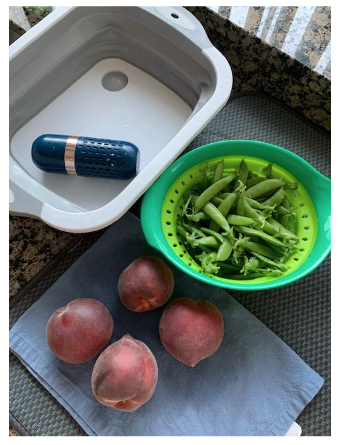Are Your Fruits and Vegetables Clean?
Two Great Ways to Wash Your Produce!
Eating clean is a term used to describe the type of nutrition consumed. Such as minimizing junk food, processed sugar, simple carbs, and non-grass-fed meats. That is one aspect, but have you ever wondered what is on the surface of your produce?
- What has it been sprayed with?
- What kind of organic fertilizer has been used?
- How has it been processed for shipment?
- Who has handled it?
Those are all hard-to-answer questions and I can’t imagine anyone who wants to spend time researching the answer. There is another way to address those questions.
Out of habit, I rinse all my produce when I get home. Some people rinse the produce right before it’s eaten and some may not rinse it at all. Rinsing does reduce dirt, germs, and pesticides. Soap, detergent, or commercial washes have not been proven to be any more effective than water alone. Soap products can get trapped in the pores of produce.
Rinsing isn’t enough.
Produce can have dirt, germs, and pesticide residue on them right up to the time you make the salad! The FDA, USDA, and EPA control the amount of allowed pesticide residue. My rule of thumb is let’s get as much off of the produce as possible.
Contrary to many beliefs, organic produce needs as much attention as nonorganic produce. Nonorganic produce needs extra help in eliminating surface pesticides. There isn’t much you can do about absorbed pesticides. Organic produce also needs a bit of help because the organic materials used, especially fertilizer, can leave harmful bacteria on the surface. Organic produce is not pesticide-free but does have a lower amount than nonorganic produce.
No method is 100% effective, however, there are many advertised methods that clean produce including water, baking soda, vinegar, salt, bleach (please don’t use bleach), thyme, hydrogen peroxide, citrus essential oils, castile soap, and various cleaning sprays. Here are two of my favorite methods that will keep all nutrients intact.
Ultrasonic OH-ion Purification Technology

This device goes the extra mile after a good rinse. It uses electrolysis to clean produce in a container of water, decomposing the water (H2O) into OH- and H+. The OH- particles destroy the molecular structure of pesticides and the oxidation kills bacteria without affecting the produce. To be fair, I only know the result and that is seeing how dirty the water is after using this device as well as picking out a worm here and there, all after rinsing the produce first. It may be hard to see the difference between the pictures, but it was an eye-opener to see it in person. The water on the right is light brown.

Baking Soda
Baking soda was tested against vinegar using grapes and a pesticide detection card. The winner was baking soda. Baking soda is a mild abrasive and slightly alkaline which is why it can break down pesticides that are not stable at an alkaline pH. It is also a natural disinfectant that can help kill harmful microorganisms. Two teaspoons of baking soda per one quart of water – soak produce for 12- 15 minutes.
What Companies Use
Most companies use bleach to wash pesticides off the surface of produce. Let’s see how it does in comparison to water and baking soda.

I think we can all agree that washing produce is better for our health in the long run. Especially with the assault of toxins in the environment that our system has to detoxify daily. Washing produce isn’t difficult or time-consuming. Ten minutes with the OH-ion purification unit or twelve minutes in a baking soda bath will suffice.
To your health,
Dr. Gerda
Doctor of Natural Medicine and Holistic Cancer Consultant
Disclaimer: The information in this blog is intended for educational purposes only. As a Board-Certified Doctor of Natural Medicine, I do not diagnose or treat disease, an area well attended by licensed physicians. Instead, I identify healing opportunities within the body, such as the immune system, digestion, detoxification, energy, cellular, and nervous systems. Once identified, function and health may be restored by correcting the underlying causes and conditions of health challenges. Rebalancing the body’s systems can be a proven stabilizer adjunctive to medical protocols. Not all recommendations may be appropriate for everyone. Due diligence and a consultation with your physician before engaging in alternative concepts or protocols are recommended.
